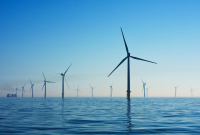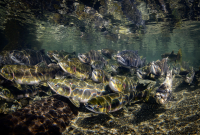Support strong Canadian climate journalism for 2025
Nova Scotia is hoping to join the offshore oil and gas rush taking place in the Atlantic Ocean, where its neighbour Newfoundland and Labrador is planning to double offshore oil production by the end of the decade.
The Canada-Nova Scotia Offshore Petroleum Board (C-NSOPB), which regulates oil and gas activity off the coast, has put out a call for companies to bid on exploring eight available parcels hundreds of kilometres offshore.
The invitation comes after a lull in exploration activity. Environmental groups, like the Sierra Club, celebrated in January when they noted “BP and Equinor abandoned the last remaining oil leases offshore Nova Scotia.”
The new call for bids flies in the face of mounting evidence the world needs to slow down fossil fuel production and halt new project approvals to have a chance of staying within 1.5 C of global warming, environmentalists say.
The move inviting companies to explore for oil and gas also follows an announcement earlier this year that the C-NSOPB was shifting its “primary focus” to renewable energy projects.
If awarded, exploration licences allow oil and gas companies to conduct seismic surveys and use exploratory drilling (in Nova Scotia’s case, after an environmental assessment) to find oil and gas deposits. The process is harmful to marine life, carries some similar risks to full-blown extraction and ultimately leads to more oil and gas projects. The interactive map below shows each available exploration bid.
In April, the C-NSOPB said it was changing its name to the Canada-Nova Scotia Offshore Energy Board. The decision is meant to “facilitate the transition to a clean economy and create sustainable jobs” and shift away from its previous mandate of “enabling safe and responsible development of Canada-Nova Scotia’s offshore petroleum resources,” but the board also noted it didn’t mean an end to new fossil fuel projects.
At the time, efforts to set a new direction for the board seemed at odds with commitments to expand oil and gas on the province’s website, where the government describes its offshore as “rich” with potential for oil and gas. “It’s already been tapped with the Sable Offshore Energy and the Deep Panuke Project. And there’s more to come. Lots more,” reads the site. The province estimates there are 120 trillion cubic feet of natural gas and eight billion barrels of oil offshore.
Currently, there’s only one active offshore gas project in Nova Scotia waters — the Sable Offshore Energy Project, which has been decommissioned and is in the monitoring phase, where the project’s well plug and abandonment is periodically checked. Its five offshore fields operated from 1999 to 2018 and produced 2.1 trillion cubic feet of natural gas during that time.

Another gas project located about 250 kilometres southeast of Halifax, Deep Panuke, has been officially abandoned. So has the Cohasset Panuke, which produced oil between 1992 and 1999.
There are some active exploration bids, but much fewer than the province’s neighbour, Newfoundland and Labrador. The majority of the new bidding areas in Nova Scotia sit on the Scotian Shelf and Slope, one of the most fished areas of the Atlantic Ocean known for its abundance of marine life. Two are around Sable Island, which is a national park reserve home to wild horses and grey seals.
The board said its call for bids is still in line with its current mandate.
“At present, we are exclusively an oil and gas regulator and continue to carry out legislated activities related to this mandate. Once our mandate has been expanded, we will be responsible for regulating both oil and gas activities and offshore renewable energy projects,” the board said in a statement to Canada’s National Observer.
Natural Resources Canada chimed in with a similar response, saying the expanded mandate will “also enable the Governments of Canada and Nova Scotia to capitalize on the growing potential of offshore wind and other renewable energy technologies.”
“However, before offshore renewable energy projects can move forward in the Canada-Nova Scotia offshore area, work needs to take place to implement the new mandate, including amending the Accord Acts and completing a regional assessment for offshore wind energy with Nova Scotia,” the department said.
The push for exploration is happening elsewhere. In Newfoundland and Labrador, 28 parcels spanning more than seven million hectares are up for bid this year in the province’s eastern region, while 10 parcels covering 2.6 million hectares are available in the southeast area off its coast. This month, the British government also opened a new group of offshore exploration licences.
Environmentalists and experts have been quick to speak out against the uptick in offshore oil and gas. Gretchen Fitzgerald, national programs director for Sierra Club Canada, said the move to offer new bids is a “direct contradiction” to the board’s name change, and that announcing new bids after hurricane Fiona “adds insult to injury.”
The group is currently involved in a lawsuit against the approval of deepwater offshore oil project Bay du Nord in Newfoundland and Labrador, which has been coupled with an uptick in oil exploration off the coast.
— With files from John Woodside






Comments
Canada is a petro-state and the fossil fuel industry has captured many of our democratic institutions. Canada is following the Norwegian example in order to gain praise for electrifying most things at home while ramping up fossil fuel production and exports to other countries. There are many better choices available now if there was only the will to do the right thing for a change.
Reference: A Solution to Global Warming, Air Pollution and Energy Insecurity for Canada, Jacobson MZ, Stanford 2021-10-23: https://web.stanford.edu/group/efmh/jacobson/Articles/I/145Country/21-W…
You'd think someone with decision-making capacity along Canada's east coast would get the connection between their fossil fuel industries, and the climate disasters they've been experiencing.
Or the voters. One or the other.